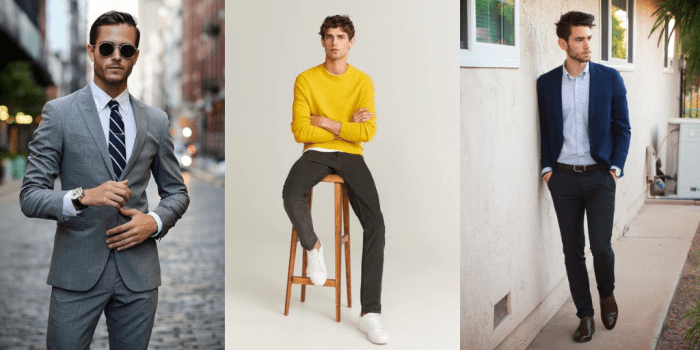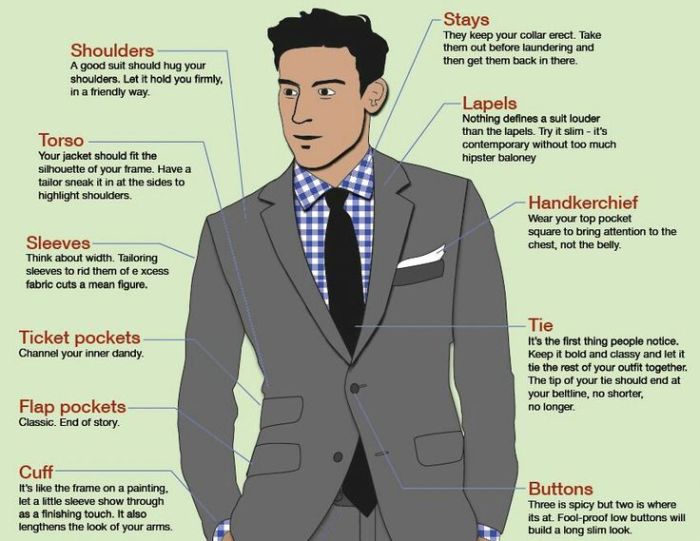Tips for Mens Fashion A Style Guide
Building a Capsule Wardrobe
Tips for mens fashion – A capsule wardrobe is a collection of essential, versatile clothing items that can be mixed and matched to create a variety of outfits. This minimalist approach simplifies your daily dressing routine while ensuring you always look polished and put-together.
Designing a Minimalist Capsule Wardrobe for a Professional Man
A professional man’s capsule wardrobe should focus on neutral colors and classic styles that can be easily dressed up or down. The core of the wardrobe should consist of high-quality, well-fitting pieces that will last for years.
- Tops: 2-3 white dress shirts, 2-3 button-down shirts in neutral colors (navy, light blue, grey), 2-3 t-shirts in neutral colors.
- Bottoms: 2 pairs of dark-wash jeans, 2 pairs of dress trousers (navy, grey), 1 pair of chinos.
- Outerwear: 1 navy blazer, 1 trench coat or a versatile jacket (leather or bomber).
- Shoes: 1 pair of black oxfords, 1 pair of brown oxfords or loafers, 1 pair of versatile sneakers.
Ten Essential Items Every Man Should Own
This list categorizes essential items for different seasons, focusing on versatility and durability.
- Spring/Summer: Chinos, linen shirt, light-weight cotton t-shirts, boat shoes, sunglasses.
- Autumn/Winter: Dark wash jeans, wool sweater, wool overcoat, Chelsea boots, leather gloves.
Five Outfit Combinations from a Capsule Wardrobe
These outfits demonstrate the versatility of a well-chosen capsule wardrobe.
- Business Casual: Chinos, button-down shirt (light blue), blazer, loafers.
- Formal: Dress trousers (navy), white dress shirt, navy blazer, black oxfords.
- Smart Casual: Dark wash jeans, button-down shirt (grey), leather jacket, Chelsea boots.
- Weekend Casual: T-shirt, chinos, sneakers.
- Date Night: Dark wash jeans, button-down shirt (navy), blazer, loafers.
Benefits of a Capsule Wardrobe
A capsule wardrobe simplifies decision-making, reduces clothing clutter, encourages thoughtful purchases, and promotes a more sustainable approach to fashion.
Mastering Essential Menswear Styles
Understanding the nuances between casual, smart casual, and formal menswear styles is crucial for dressing appropriately for any occasion.
Casual Menswear
Casual style emphasizes comfort and relaxed fits. Denim, t-shirts, and sneakers are staples. Layering is key to adding visual interest.
- Example Outfit: T-shirt, jeans, sneakers, bomber jacket.
Smart Casual Menswear
Smart casual blends comfort and style. It’s appropriate for many social and semi-professional settings. Think chinos, button-down shirts, and loafers.
- Example Outfit: Chinos, button-down shirt, loafers, blazer (optional).
Formal Menswear
Formal menswear is reserved for highly professional or formal events. Suits, dress shirts, ties, and dress shoes are essential. Attention to detail is paramount.
- Example Outfit: Suit, dress shirt, tie, dress shoes.
Color and Pattern Usage Across Styles
Casual styles often utilize bolder colors and patterns, while smart casual and formal styles generally favor more muted tones and subtle patterns.
Fit and Tailoring, Tips for mens fashion
Proper fit and tailoring are essential for achieving a polished look in all styles. Well-fitting clothes enhance your silhouette and create a more refined appearance.
Choosing the Right Accessories

Source: styl-inc.com
Accessories can elevate even the simplest outfit. Careful selection is key to achieving a cohesive and stylish look.
Selecting Belts, Watches, and Shoes
Belts should complement your shoes and trousers in color and material. Watches should reflect your personal style and the occasion. Shoes should be appropriate for the outfit and occasion.
Impact of Socks

Source: pinimg.com
Socks should complement your trousers and shoes, avoiding clashing colors or patterns. The material and length of your socks should be appropriate for the occasion.
Key Accessories to Elevate an Outfit
A well-chosen watch, a quality belt, and a stylish scarf can transform a simple outfit into something more sophisticated.
Types of Ties
Different tie types are suitable for different occasions. Silk ties are classic and versatile, while knit ties offer a more casual feel. Bow ties are often associated with formal events.
| Tie Type | Material | Occasion | Description |
|---|---|---|---|
| Silk Tie | Silk | Formal, Business | Classic and versatile, ideal for formal events and business settings. |
| Knit Tie | Wool, Silk, or Cotton | Casual, Smart Casual | Offers a more relaxed and textured look, suitable for less formal occasions. |
| Bow Tie | Silk, Cotton | Formal, Black Tie | Often worn with tuxedos or formal suits for special events. |
Understanding Fabric and Fit
The choice of fabric and the fit of your clothing significantly impact your overall appearance and comfort.
Characteristics of Common Fabrics
Cotton is breathable and comfortable, linen is lightweight and breathable, wool is warm and durable, and silk is luxurious and smooth. Each fabric has unique properties that make it suitable for different garments and climates.
Determining Correct Fit
Proper fit ensures comfort and a polished appearance. Shirts should fit snugly but not tightly, trousers should fit comfortably at the waist and leg, and jackets should allow for comfortable arm movement without being too loose or too tight.
Importance of Tailoring
Tailoring can transform an off-the-rack garment into a perfectly fitting piece. It ensures a clean, sharp look and enhances your silhouette.
Fabric Drape and Body Types
Different fabrics drape differently and suit different body types. Lighter fabrics can be more flattering on larger body types, while heavier fabrics can add structure to a slimmer frame.
Personal Style and Grooming
Developing a personal style that reflects your personality and flatters your body type is essential for looking and feeling your best.
Choosing Clothing that Flatters Different Body Types
Understanding your body type allows you to choose clothing that accentuates your best features and minimizes any areas you may be less confident about. For example, vertical stripes can lengthen a shorter frame, while darker colors can slim a larger frame.
Incorporating Personal Style into a Professional Wardrobe
Personal style can be incorporated into a professional wardrobe through subtle details such as tie patterns, pocket squares, or cufflinks. These additions can reflect your individuality without compromising professionalism.
Importance of Grooming
Grooming, including regular haircuts, beard maintenance (if applicable), and skincare, significantly impacts your overall appearance. A well-groomed appearance conveys confidence and professionalism.
Five Grooming Habits Every Man Should Adopt
These habits contribute to a polished and well-maintained appearance.
- Regular haircuts
- Consistent skincare routine
- Proper beard maintenance (if applicable)
- Nail care
- Regular dental check-ups
Shopping Smartly: Tips For Mens Fashion
Smart shopping involves finding well-made, affordable clothing while prioritizing quality over quantity.
Finding Well-Made, Affordable Clothing
Look for sales and discounts, consider buying from outlet stores, and shop during off-season for better deals. Prioritize quality materials and construction over trendy styles.
Investing in Quality Over Quantity
Investing in a few high-quality items that will last for years is more cost-effective and sustainable than constantly buying cheap, trendy clothes that quickly wear out.
Identifying Well-Constructed Garments
Look for even stitching, strong seams, quality materials, and well-finished details. Try on the garment to check for comfort and fit.
Navigating Sales and Discounts
Be aware of the original price and compare prices across different retailers. Don’t be swayed by overly aggressive discounts if the quality is compromised.
Color Coordination and Patterns
Understanding color theory and pattern usage is key to creating visually appealing outfits.
Creating Visually Appealing Outfits Using Color Theory
Using a color wheel, you can create complementary, analogous, or triadic color schemes. Experiment with different combinations to find what works best for you.
Incorporating Patterns Effectively
Patterns such as stripes, checks, and plaid can add visual interest to an outfit. However, it’s important to balance patterns with solid colors to avoid an overwhelming look.
Successful Color Combinations for Different Seasons
Warm colors such as reds, oranges, and yellows are suitable for autumn and winter, while cool colors such as blues, greens, and purples are better suited for spring and summer.
Mastering men’s fashion involves understanding proportions and choosing pieces that flatter your physique. A key element of any summer wardrobe is, of course, shorts; for stylish options and inspiration, check out this guide on shorts mens fashion. Remember to consider the overall outfit – the right shorts paired with a well-fitting shirt and shoes can elevate your style considerably.
Ultimately, confident self-expression is the best fashion tip of all.
Avoiding Common Color Coordination Mistakes
Avoid clashing colors, overusing patterns, and wearing too many bright colors at once. Stick to a balanced color scheme to create a harmonious look.
Building a Versatile Shoe Collection
A versatile shoe collection is essential for a well-rounded wardrobe. It should include options suitable for various occasions and styles.
Essential Shoe Types
- Dress shoes (oxfords, loafers)
- Sneakers (white sneakers, versatile sneakers)
- Boots (Chelsea boots, ankle boots)
- Sandals (for warm weather)
Shoe Materials
Leather is durable and versatile, suede is soft and luxurious but requires more care, canvas is breathable and casual.
Shoe Care
Proper shoe care extends the lifespan of your shoes. Regular cleaning, polishing, and storage are essential.
Query Resolution
What are some budget-friendly ways to improve my wardrobe?
Shop sales strategically, invest in versatile basics, consider secondhand clothing, and focus on quality over quantity. Prioritize timeless pieces that will last.
How can I determine my body type and dress accordingly?
Identify your body shape (e.g., athletic, slim, larger frame) and choose clothing that accentuates your best features and minimizes areas you may want to downplay. Consult online resources for guidance.
How often should I replace my shoes?
The lifespan of shoes depends on the material, frequency of wear, and care. Leather shoes can last years with proper maintenance, while others might need replacing sooner. Replace shoes when they show significant wear or damage.
What are some quick tips for looking well-groomed?
Maintain clean hair, trim nails, keep facial hair neat, and ensure clothes are clean and ironed. These small details make a big difference.





















